Choosing a College or University Level Microscope
Mar 19th 2023
What Kind of Microscope is Best for College and University Level Students?
Choosing the best microscope for your application depends on what kinds of samples you will investigate. This post will explain some points to consider when selecting a microscope.
Do I Need a Compound or a Stereo Microscope?
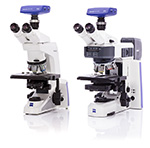 Compound Microscopes:
Compound Microscopes:
Compound or biological microscopes are designed to look at samples on prepared slides where light can pass through the sample, such as slides of bacteria or of mammalian cells. These microscopes have higher magnifications than stereo microscopes, typically between 40x and 1000x.
Here are some recommended college-level compound microscopes:
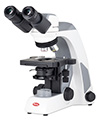 Key Features of the Panthera E2 microscope:
Key Features of the Panthera E2 microscope:
- Infinity corrected Plan UC Achromat objective lenses with magnification levels of 4x, 10x, 40x, and 100x. (Total magnification with the 10x eyepieces are 40x, 100x, 400x, and 1000x.) Achromat lenses are lenses made by combining glasses with different focal lengths to correct for chromatic aberrations, resulting in clearer images through the microscope eyepieces.
- Mechanical stage allows for easy sample manipulation.
- The back of the microscope has a sturdy carrying handle so that it can be easily moved.
- Light is provided by an LED lamp, which will provide long lasting, bright, cool light.
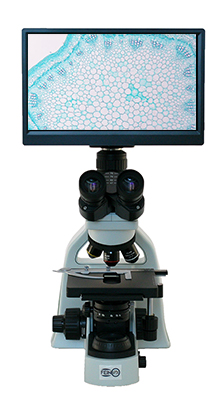 Key Features of the RB20 LCD Microscope:
Key Features of the RB20 LCD Microscope:
- Infinity corrected Plan Achromat objective lenses with magnification levels of 4x, 10x, 40x, and 100x. (Total magnification with the 10x eyepieces are 40x, 100x, 400x, and 1000x.)
- Mechanical stage allows for easy sample manipulation.
- Light is provided by an LED lamp, which will provide long lasting, bright, cool light.
- High definition camera and monitor are attached to the microscope and allow for samples to be viewed on the monitor in real time.
- Microscope has a storage compartment in the back of the frame for the storage of the power cord and accessories when not in use.
Both the ZEISS Primostar 3 and the RB20 microscope are available with various options, such as having a camera and/ or monitor. Keep reading this post for more information on adding a camera to your microscope.
Stereo microscopes:
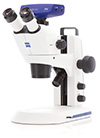 Stereo microscopes can be used for larger and opaque samples where lower magnifications are required, such as looking at worms, for dissection, or for plants. Stereo microscopes typically have magnification ranges of ~5-50 times magnification.
Stereo microscopes can be used for larger and opaque samples where lower magnifications are required, such as looking at worms, for dissection, or for plants. Stereo microscopes typically have magnification ranges of ~5-50 times magnification.
Here are some recommended college-level stereo microscopes:
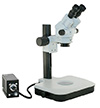 Key Features of the S6 Stereo Microscope:
Key Features of the S6 Stereo Microscope:
- Total magnification of 10x-67.5x.
- Light source is a high-intensity LED light.
- The microscope is on a track stand with a built in, tilting mirror. Samples can be viewed using either brightfield or darkfield illumination. Brightfield is the typical way of viewing samples, where the background is lit, and the sample is darker. Darkfield microscopy shows an illuminated sample on a bright background, which can improve sample contrast and visibility.
SM7 Common Main Objective Stereo Microscope
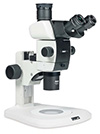 Key Features of the SM7 CMO Stereo Microscope:
Key Features of the SM7 CMO Stereo Microscope:
- Total magnification of 8x-56x.
- Common Main Objective (more light gathering power)
- Transmitted light is a high-intensity LED light providing light through the base of the stand. Reflected light is provided by an LED adjustable light.
Do You Want to Connect a Camera to Your Microscope?
 In order to connect a camera to your microscope, you must purchase a microscope with a port where the camera can be attached, called a trinocular microscope. (On binocular microscopes, samples can only be viewed through the eyepieces.) After you select a trinocular microscope, you may choose a camera that fits your needs and budget. Microscope cameras attach to the microscope via a camera mount specific to your microscope. Cameras may be changed as desired simply by detaching (unscrewing) the existing camera from your microscope and attaching a new one. Note that the size of the camera mount depends both on the type of microscope as well as the size of sensor in the camera, so changing the camera may require the purchase of a different camera mount. All of the microscopes described in this blog are available in binocular and trinocular versions, and all can easily be configured to include cameras.
In order to connect a camera to your microscope, you must purchase a microscope with a port where the camera can be attached, called a trinocular microscope. (On binocular microscopes, samples can only be viewed through the eyepieces.) After you select a trinocular microscope, you may choose a camera that fits your needs and budget. Microscope cameras attach to the microscope via a camera mount specific to your microscope. Cameras may be changed as desired simply by detaching (unscrewing) the existing camera from your microscope and attaching a new one. Note that the size of the camera mount depends both on the type of microscope as well as the size of sensor in the camera, so changing the camera may require the purchase of a different camera mount. All of the microscopes described in this blog are available in binocular and trinocular versions, and all can easily be configured to include cameras.
Please contact Microscope World for more information about setting up a digital classroom, or for any other microscope related questions.





